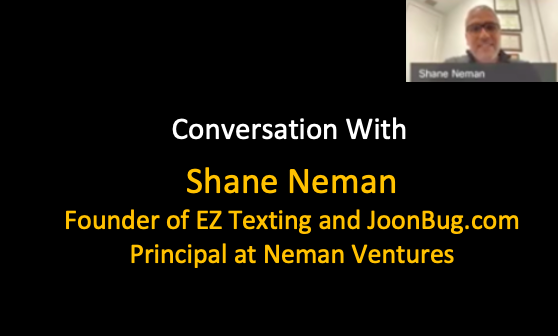Seed Capital
1Mby1M Virtual Accelerator Investor Forum: With Alok Nandan, Founder General Partner at First Rays Venture Partners (Part 2)
Sramana Mitra: You are looking for a founder that you feel good about. That is your answer.
Alok Nandan: Unfortunately, it is subjective because at the seed stage, you don’t have that many metrics to go after. Series A and beyond, you have numbers and data that you can look at. At the seed stage, you don’t have numbers. A lot of times, it is a qualitative bet and less quantitative. The qualitative bets are around the domain expertise, ability to execute and go after hard problems. Some of that is demonstrated by our past experience.
>>>530th 1Mby1M Entrepreneurship Podcast with Shane Neman, Neman Ventures
Shane Neman is Founder of EZ Texting, JoonBug.com, and Principal at Neman Ventures. Shane has bootstrapped two companies as a solo entrepreneur, found successful exits for both, and is now an investor. Needless to say, he has no bias against solopreneurs.
Podcast: Play in new window | Download
Subscribe: Apple Podcasts | Android | Google Play | Stitcher | TuneIn | RSS
Roundtable Recap: May 13 – A Solo Entrepreneur Case Study

During this week’s roundtable, we had as our guest Shane Neman, Founder of EZ Texting and JoonBug.com, Principal at Neman Ventures. Shane has bootstrapped two companies as a solo entrepreneur, found successful exits for both, and is now an investor. Needless to say, he has no bias against solo entrepreneurs.
You can listen to the recording of this roundtable here:
Best of Bootstrapping: E-commerce and Investing with Tod Francis, Shasta Ventures

If you have been bootstrapping and think you are ready for investors, you need to learn how investors think. First, please study our free Bootstrapping course and Investor Introductions page. Then start looking for entrepreneur – investor fit. Today I introduce you to Tod Francis.
Tod Francis, Managing Director at Shasta Ventures, starts with a discussion on the history of retail, all the way from shoe stores, to departmental stores, and back to specialty retail. This is followed by a similar overview of the history of e-commerce ranging from Amazon’s strategy to how specialty retail is translating into niche e-commerce, and how Tod is looking at investments in the category. You can listen to the podcast interview here and the entire roundtable program here:
231st 1Mby1M Entrepreneurship Podcast with Tod Francis, Shasta Ventures
Tod Francis, Managing Director at Shasta Ventures, starts with a discussion on the history of retail, all the way from shoe stores, to departmental stores, and back to specialty retail. This is followed by a similar overview of the history of e-commerce ranging from Amazon’s strategy to how specialty retail is translating into niche e-commerce, and how Tod is looking at investments in the category.
Podcast: Play in new window | Download
Subscribe: Apple Podcasts | Android | Google Play | Stitcher | TuneIn | RSS
1Mby1M Virtual Accelerator Investor Forum: With Sumant Mandal, Co-Founder and Managing Partner at March Capital (Part 6)
Sramana Mitra: You have been around for a long time and so have I. We have come from this era in Silicon Valley where people would not invest in companies that are more than 15 miles away from them. Now, people are investing without meeting people. What is your current thesis around what geography you are comfortable investing in?
Sumant Mandal: We, as a firm, never have been of the mindset that if I live in Southern California, then I want to be a Southern Californian investor. I was with one of my investors yesterday. I’ve lived in the Los Angeles – Santa Monica area for 20 years. I have been investing for 20 years, but I have only invested in two companies in LA.
>>>1Mby1M Virtual Accelerator Investor Forum: With Sumant Mandal, Co-Founder and Managing Partner at March Capital (Part 5)
Sramana Mitra: What we also see in the Bootstrapping to Exit mode of company building is a lot of acquisition hires. We have sold companies in our portfolio in that mode. These are typically companies with a little bit of angel financing that go straight for an exit. We pulled a company to Qualys, for example, in this mode.
That is all about talent. Whether they are going to stick with the same product strategy or not, what they are looking for is the team. That happens a lot in the business.
>>>1Mby1M Virtual Accelerator Investor Forum: With Sumant Mandal, Co-Founder and Managing Partner at March Capital (Part 4)
Sramana Mitra: The pool of talent has also broadened. Even a little country like Uruguay now has a couple of unicorns. I remember we did a case study a long time ago where there were two founders that met on the internet. One was from Ireland and the other was from Montevideo in Uruguay.
When I saw this unicorn from Uruguay, I was like, “Wow. A little country has come up in the process.” Estonia, of course, is churning out unicorn after unicorn and has become a startup nation. There are some interesting talent sourcing and team architecture changes that are happening in the world right now in how companies are being built.
>>>